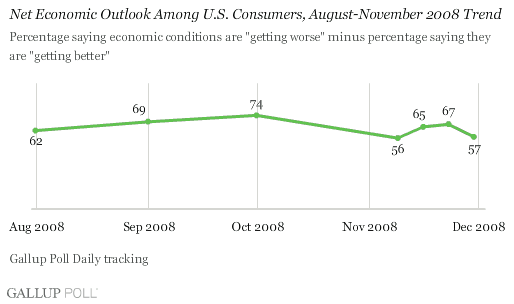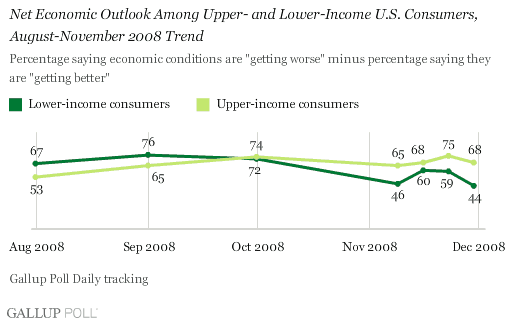PRINCETON, NJ -- Thanksgiving week found consumers more optimistic about than they had been for most of November. The percentage of consumers saying the economy is "getting worse" outnumbered the percentage saying it is "getting better" by a smaller margin than in previous weeks -- most notably in September and October as the financial crisis intensified -- matching its election-week level.

Lower-Income Consumers More Optimistic Than Upper-Income Consumers
A sharp improvement in optimism about the future direction of the economy among lower-income Americans -- those with monthly household incomes of less than $2,000 -- appears to be the key driver of the sharp improvement in overall consumer optimism during election week and then again as November came to a close. The percentage of this group saying the economy is getting worse minus the percentage saying it is getting better fell from 72 points in October to 46 points during election week. After giving back some of this improvement during the next two weeks, this net "getting worse" measure fell again during Thanksgiving week, to 44 points. With gas prices falling below $2 a gallon and disparate retailers offering sharp discounts, it seems logical that lower-income consumers' optimism would improve, not only in response to the holidays but also as their disposable incomes buy more.
Among upper-income consumers -- those with monthly incomes of $7,500 or more -- optimism also improved during election week, albeit more modestly. The net "getting worse" measure among upper-income consumers fell from 74 points in October to 65 during election week. It gave back this improvement over the next two weeks, but ended Thanksgiving week at 68 -- essentially where it had been at the beginning of November. Although upper-income consumers are also benefiting from plunging gas prices and sharply slashed consumer prices, ever-lower home and equity prices seem to have combined with the continuing credit crunch to more than offset those benefits. Changes in the housing and stock markets are probably more likely to affect upper-income consumers, and thus may enter more into their evaluations of the overall economy.

Commentary
The improvement in economic outlook among lower-income Americans is good for the economy and, in particular, for the low-cost retailers who serve them. Spending less on gas at the pump and more on food and other consumer goods should make for a better holiday for these Americans.
However, Gallup's finding that upper-income consumers remain substantially less optimistic about the economy than their lower-income counterparts is a major reason for concern. Upper-income consumers have more disposable income and, as a result, tend to drive overall consumer spending to a greater degree. As upper-income consumers pull back, a sharp contraction in economic activity follows and the current recession deepens.
Ironically, while President-elect Obama may have emphasized his willingness to make things better for lower- and middle-income Americans -- and this may already be starting to be reflected in lower-income consumer optimism -- the Obama administration's key challenge early next year may involve rebuilding the confidence and optimism of upper-middle- and upper-income Americans. It is not only the balance sheets of banks and corporate America that have been devastated by the financial crisis, but also the personal balance sheets of millions of Americans who have seen much of their life savings disappear.
Jobs are likely to take center stage economically later this week. Thursday's report on weekly jobless claims showed they were down from the prior week and the four-week seasonally adjusted average jobless claims were up, . In this regard, Gallup's new hiring measure projects that the U.S. unemployment rate will surge to 7% and could go even higher when reported Friday morning. While this is likely to set off even more economic alarm bells, jobs are only one of the major challenges facing the new Obama economic team. Stabilizing asset values may prove an even more difficult challenge.
Author's update, Friday, Dec. 05, 2008: Friday's report that the U.S. economy lost 533,000 jobs in November was consistent with Gallup's data. However, the increase in the unemployment rate to 6.7% in November from 6.5% in October is not consistent with the loss of more than 500,000 jobs last month nor with Gallup's new hiring measure. Both of these -- job losses and net new hiring -- suggest the U.S. unemployment rate should be at 7% or even higher and it is likely to surge past 7% when next reported in January. The new Congress is likely to face a new jobs report showing more than 2 million jobs lost in 2008 and a December unemployment rate surpassing 7% when it starts work in January. As a result, it seems highly unlikely that there will be any resistance to a massive stimulus package passing quickly so President-elect Obama can sign it immediately after his inauguration.
Survey Methods
���۴�ýis interviewing no fewer than 1,000 U.S. adults nationwide each day during 2008. The economic questions analyzed in this report are asked of a random half-sample of respondents each day. The results reported here are based on combined data of more than 8,000 interviews each month, conducted in August, September, and October. For results based on these samples, the maximum margin of sampling error is ±1 percentage point.
The results for polling in November are based on combined data of approximately 3,000 interviews each week, conducted Nov. 3-9, Nov. 10-16, Nov. 17-23, and Nov. 24-30, 2008. For results based on these samples, the maximum margin of sampling error is ±2 percentage points.
Interviews are conducted with respondents on land-line telephones (for respondents with a land-line telephone) and cellular phones (for respondents who are cell-phone only).
In addition to sampling error, question wording and practical difficulties in conducting surveys can introduce error or bias into the findings of public opinion polls.
